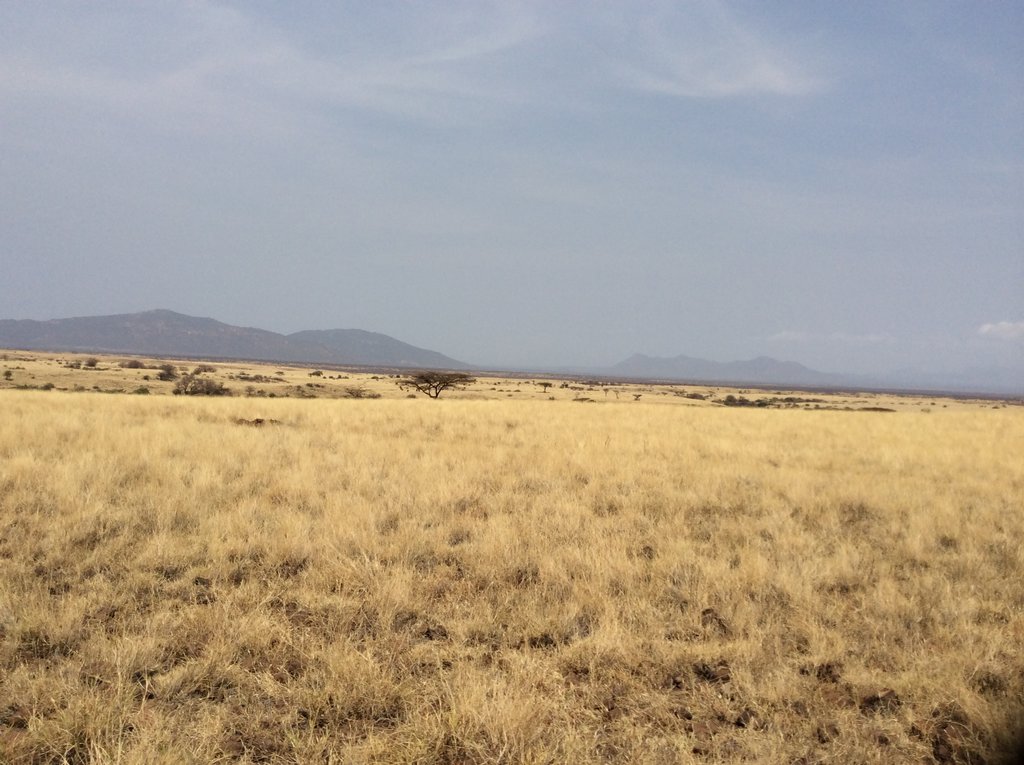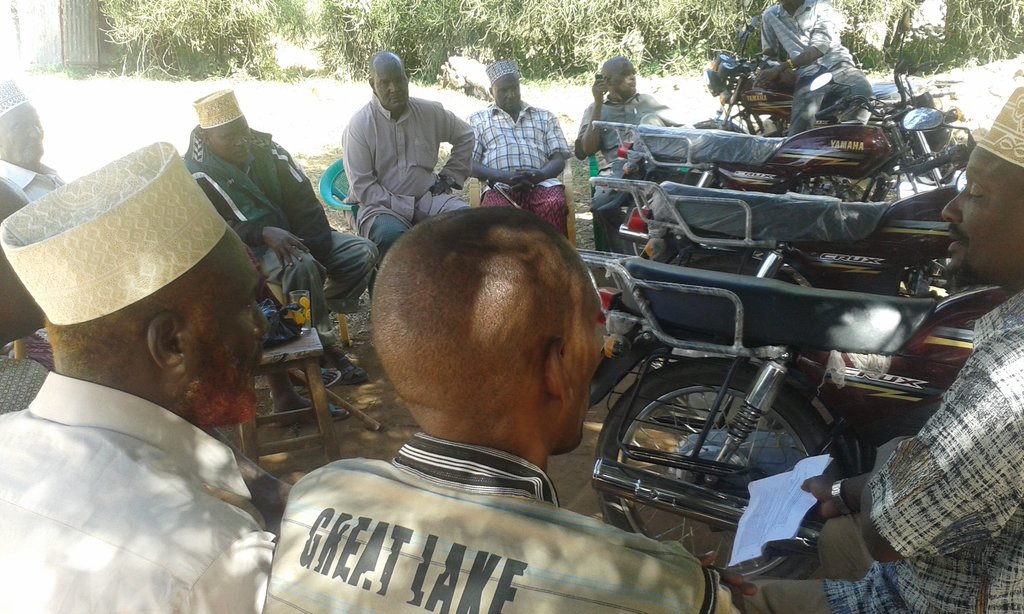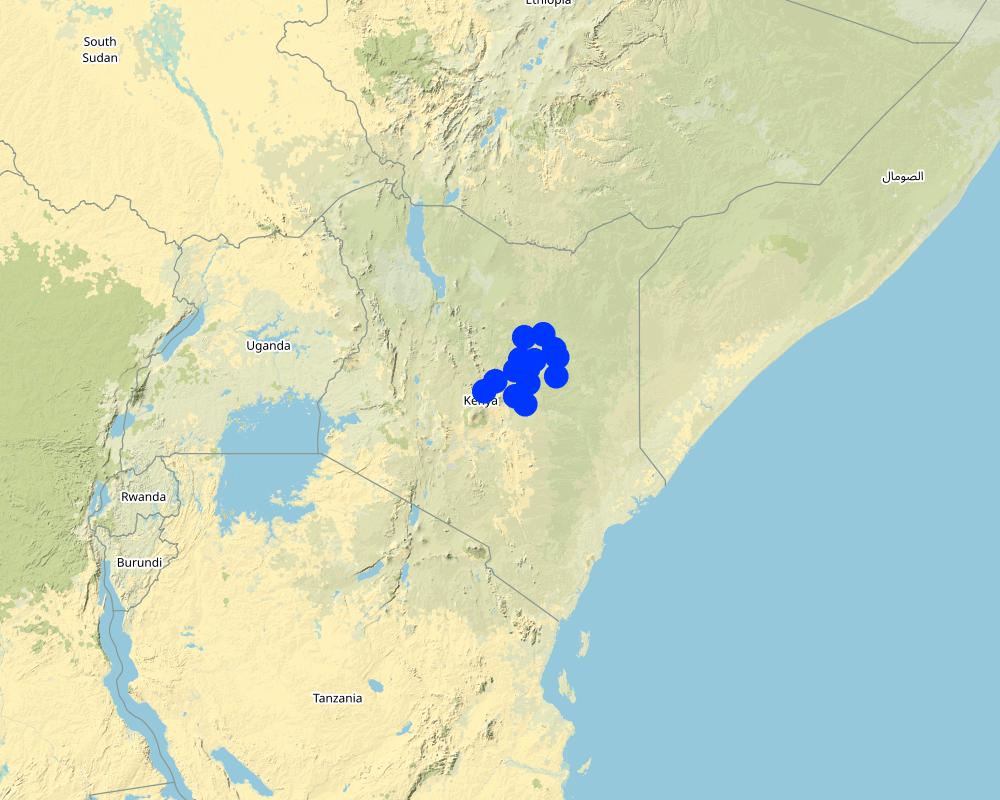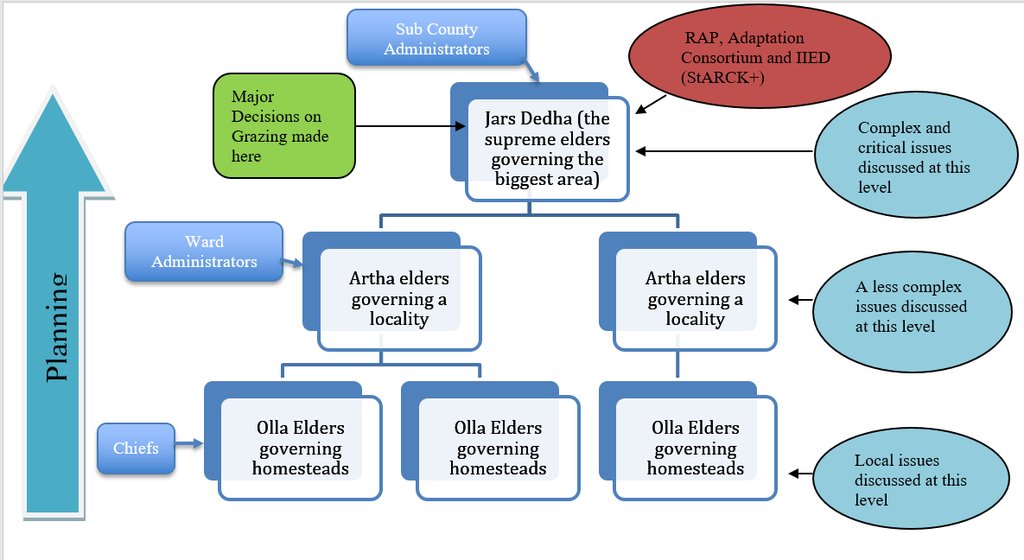Empowering Dedha institutions in governing the natural resources of Isiolo rangelands [เคนยา]
- ผู้สร้างสรรค์:
- การอัพเดท:
- ผู้รวบรวม: IBRAHIM JARSO
- ผู้เรียบเรียง: Caroline King-Okumu
- ผู้ตรวจสอบ: Hanspeter Liniger, Rima Mekdaschi Studer, Donia Mühlematter, Joana Eichenberger
Jars Dedha
approaches_3345 - เคนยา
- บทสรุปทั้งหมดในรูปแบบของ PDF
- บทสรุปทั้งหมดในรูปแบบของ PDF เพื่อพิมพ์
- บทสรุปทั้งหมดในรูปหน้าเว็บ
- บทสรุปทั้งหมด (ไม่มีการจัดเรียง)
- Empowering Dedha institutions in governing the natural resources of Isiolo rangelands: 13 พฤษภาคม 2018 (inactive)
- Empowering Dedha institutions in governing the natural resources of Isiolo rangelands: 31 กรกฎาคม 2018 (inactive)
- Empowering Dedha institutions in governing the natural resources of Isiolo rangelands: 3 กันยายน 2018 (inactive)
- Empowering Dedha institutions in governing the natural resources of Isiolo rangelands: 2 พฤศจิกายน 2021 (public)
ดูส่วนย่อย
ขยายทั้งหมด ย่อทั้งหมด1. ข้อมูลทั่วไป
1.2 รายละเอียดที่ติดต่อได้ของผู้รวบรวมและองค์กรที่เกี่ยวข้องในการประเมินและการจัดเตรียมทำเอกสารของแนวทาง
ผู้ใช้ที่ดิน:
Boru Edin
+254 715 627 545
Kinna Dedha Elders
Kinna town, Kinna Ward, Isiolo County.
เคนยา
Non-State Actor:
Jama Abdiaziz
+254 707 720 577
aziz2012ke@gmail.com
Pastoralist Capacity Development Programme (PACDEP)
Isiolo Town, Kenya
เคนยา
ผู้ใช้ที่ดิน:
Diba Rukia
+254 728 643 044
Ward Adaptation Planning Committee
Kinna, Isiolo County
เคนยา
ผู้เชี่ยวชาญ SLM:
ชื่อของโครงการซึ่งอำนวยความสะดวกในการทำเอกสารหรือการประเมินแนวทาง (ถ้าเกี่ยวข้อง)
Strengthening Adaptation and Resilience to Climate Change in Kenya Plus (StARCK+)ชื่อของโครงการซึ่งอำนวยความสะดวกในการทำเอกสารหรือการประเมินแนวทาง (ถ้าเกี่ยวข้อง)
Book project: Guidelines to Rangeland Management in Sub-Saharan Africa (Rangeland Management)ชื่อของโครงการซึ่งอำนวยความสะดวกในการทำเอกสารหรือการประเมินแนวทาง (ถ้าเกี่ยวข้อง)
Resource Advocacy Programme (RAP) - เคนยา1.3 เงื่อนไขที่เกี่ยวข้องกับการใช้ข้อมูลที่ได้บันทึกไว้ผ่านทาง WOCAT
วันที่เก็บรวบรวมข้อมูล (ภาคสนาม):
03/11/2017
ผู้รวบรวมและวิทยากรหลักยอมรับเงื่อนไขเกี่ยวกับการใช้ข้อมูลที่ถูกบันทึกผ่านทาง WOCAT:
ใช่
2. คำอธิบายของแนวทาง SLM
2.1 การอธิบายแบบสั้น ๆ ของแนวทาง
This approach – driven by communities and supported by various agencies - aims to revive and strengthen the traditional natural resource management institutions of Boran pastoralists in Northern Kenya. The traditional system, which was devised by the Boran pastoral community and honed over centuries to suit the challenges of the rangelands, has been steadily eroded by external factors and formalised systems after the emergence of the nation-state.
2.2 การอธิบายอย่างละเอียดของแนวทาง
การอธิบายอย่างละเอียดของแนวทาง:
Pastoral Community Members together with the Jarsa Dedha (the council of elders who control the use of grazing land and its resources) are at the forefront of reinvigorating traditions of rangeland management. To achieve this, they have been supported by organizations including the Ward Adaptation Planning Committees (WAPC), the Resource Advocacy Programme (RAP) and the International Institute for Environment and Development (IIED). There has been a focus on reviving traditional institutions and systems of managing of natural resources to help communities adapt to climate change.
One specific project that has assisted the re-empowerment of the Dedha institutions was StARCK+ (funded by DfID). StARCK+ was founded on an understanding and an appreciation of the traditional natural resource governance of the Boran pastoral community. Responding to participatory demand it undertook to help strengthen this customary natural resource management system. Various agencies have also conducted research on the traditional institution and investigated how it could be improved. These include IIED, (UK), the University of Nairobi, (Kenya) and the University of Sussex (UK).
The Jarsa Dedha is an indigenous institution, through which customary laws and provisions guide the management of natural resources. The Boran of Isiolo County, Kenya, like their kin in southern Ethiopia, derive their customary laws from an overall supreme general assembly called the Gadha. The Gadha governing council preserves traditional laws and codes of conduct, as well as issuing amendments and additions based on the evolving environmental, social and cultural context. The Gadha system has a set of laws and provisions (seere), customs and culture (aada), and norms and values that govern society.
The recognition and observance of seere and aada are still considered vital for the wellbeing of the community, and the Gadha Council remains a legitimate institution in the eyes of Borana society. However, adherence to these laws is declining and the power of Borana customary institutions to enforce regulations is being undermined in a number of ways.
The reasons for weakening traditional institutions are basically poor recognition by the county and national government, and non-compliance with the rules due to changing socio-cultural norms. The council of elders that govern grazing resources, the Jarsa Dedha, which is the custodian of these unwritten rules and regulations locally, no longer has sufficient capacity or authority to enforce them as it had done prior to colonial rule. With climate change, pasture and water supplies are becoming scarcer and there is no other better way to govern land than the traditional system: that is why reviving, strengthening and improving the system was much welcomed through the advent of the StARCK+ project and the initiatives and support that have followed.
Looking towards the future, the rules of governing natural resources have been collected and formed into a draft county customary natural resource governance bill. This, if passed by the County Assembly, would represent a very significant step, by legitimising the traditional system of rangeland management through the Jarsa Dedha.
2.3 รูปภาพของแนวทาง
2.4 วีดีโอของแนวทาง
ความคิดเห็น อธิบายสั้นๆ:
The video clearly defines the technology and the approach
วันที่:
20/02/2015
สถานที่:
Garbatulla Area
ชื่อของผู้ถ่ายวีดีโอ:
Hilda Kathure
2.5 ประเทศ ภูมิภาค หรือสถานที่ตั้งที่ได้นำแนวทางไปใช้
ประเทศ:
เคนยา
ภูมิภาค/รัฐ/จังหวัด: :
Isiolo
ข้อมูลเฉพาะเพิ่มเติมของสถานที่ตั้ง:
Pastoral areas of Isiolo
Map
×2.6 วันที่เริ่มต้นและสิ้นสุดของแนวทาง
ระบุปีที่เริ่ม:
2012
ถ้าไม่รู้ปีที่แน่นอนให้ประมาณวันที่ที่ริเริ่มใช้แนวทางนี้ :
น้อยกว่า 10 ปี (เร็วๆนี้)
ความคิดเห็น:
The project started 2012 and ended 2016 but the approach is still continuing
2.7 ประเภทของแนวทาง
- แบบดั้งเดิม/ แบบพื้นเมิอง
2.8 เป้าหมายหรือวัตถุประสงค์หลักของแนวทาง
The Approach is aimed at strenghthening and re-empowering the traditional institutions that govern rangeland management in the rangelands of Isiolo, in order to improve utilisation of natural resources and build community resilience to droughts and future environmental changes.
2.9 เงื่อนไขที่เอื้ออำนวยหรือเป็นอุปสรรคต่อการนำเทคโนโลยีภายใต้แนวทางนี้ไปปฏิบัติใช้
บรรทัดฐานและค่านิยมทางสังคม วัฒนธรรม ศาสนา
- เอื้ออำนวย
The approach was traditional and embedded in the culture of boran pastoralists and therefore easy to implement.
- เป็นอุปสรรค
The commercialization of livestock and its production like milk has made it difficult for elders to implement the approach.
การมีไว้ให้หรือการเข้าถึงแหล่งการเงินและบริการ
- เอื้ออำนวย
Communities make their own contributions to support implementation of the approach.
- เป็นอุปสรรค
No specific budget assigned by government authority for this approach: some funds from projects and county government and contributions from the pastoralists themselves.
การจัดตั้งระดับองค์กร
- เอื้ออำนวย
Well elaborated organizational design at all levels of institutional scale.
- เป็นอุปสรรค
Collision between the mandates of traditional structure and formal structure. This was addressed through accepting Chiefs as ex-official members in the Dedha council of elders.
การร่วมมือหรือการทำงานประสานกันของผู้ลงมือปฏิบัติ
- เอื้ออำนวย
Many NGOs and local organization support the implementation of the approach through providing means for surveillance such as vehicles or motorbikes. NGOs frequently also support Dedha assemblies that involve meetings of people from far away.
- เป็นอุปสรรค
Government and some NGOs sometimes establish parallel grazing committees.
กรอบแนวทางในการดำเนินการด้านกฎหมาย (การถือครองที่ดิน สิทธิในการใช้ที่ดินและน้ำ)
- เอื้ออำนวย
Traditional tenure system.
- เป็นอุปสรรค
No legal papers for the ownership.
นโยบาย
- เอื้ออำนวย
Traditional provisions and rules known by all community members.
- เป็นอุปสรรค
Traditional rules not known to everyone.
การกำกับดูแลที่ดิน (การตัดสินใจ การนำเอาไปปฏิบัติใช้ และการบังคับใช้)
- เอื้ออำนวย
Elders make key decisions on governance of land.
- เป็นอุปสรรค
Women and youth not well involved in decision making although changes are happening nowadays to include them.
ความรู้เกี่ยวกับ SLM การเข้าถึงการสนับสนุนด้านเทคนิค
- เอื้ออำนวย
Traditional skills much used.
- เป็นอุปสรรค
Little technical support.
ตลาด (จัดซื้อปัจจัยนำเข้า ขายผลิตภัณฑ์) และราคา
- เอื้ออำนวย
Ensures security and market thrives.
- เป็นอุปสรรค
The approach is more social and not market oriented.
ปริมาณงานที่ทำได้ กำลังคนที่มีให้
- เอื้ออำนวย
Youth provide man power Voluntarily.
- เป็นอุปสรรค
Volunteers sometimes don’t come out for work.
3. การมีส่วนร่วมและบทบาทของผู้มีส่วนได้ส่วนเสียที่เกี่ยวข้อง
3.1 ผู้มีส่วนได้ส่วนเสียที่เกี่ยวข้องในแนวทางนี้และบทบาท
- ผู้ใช้ที่ดินระดับท้องถิ่นหรือชุมชนระดับท้องถิ่น
Boran Community members, Dedha elders.
Agree on the pasture and water management approach and implement .
- องค์กรที่ขึ้นอยู่กับชุมชน
Ward Adaptation Planning Committees.
Implement community plans and fundraise for it.
- องค์กรพัฒนาเอกชน
Resource Advocacy Programme (RAP), Merti Integrated Development Programme (MIDP), Pastoralist A Capacity Development E Programme (PACDEP), International Institute for Environment Development and Adaptation Consortium (ADA)
Support communities in implementing the approach.
Ward Adaptation Planning Committees; Implement community plans and fundraise for it.
ถ้ามีผู้มีส่วนได้ส่วนเสียหลายคนที่เกี่ยวข้องให้ระบุหน่วยงานตัวแทน:
WAPC , ADA and IIED
3.2 การเกี่ยวข้องของผู้ใช้ที่ดินระดับท้องถิ่นหรือชุมชนระดับท้องถิ่นในช่วงต่างๆของแนวทาง
| ความเกี่ยวข้องของผู้ใช้ที่ดินระดับท้องถิ่นหรือชุมชนระดับท้องถิ่น | ระบุผู้ที่มีส่วนเกี่ยวข้องและอธิบายกิจกรรม | |
|---|---|---|
| การริเริ่มหรือการจูงใจ | ปฏิสัมพันธ์ | Pastoral Community Members, Dedha elders and supporting organizations like WAPC, RAP, IIED and DfID supported the process of reviving the traditional system of management of natural resources to help communities adapt to climate change. |
| การวางแผน | ปฏิสัมพันธ์ | Pastoral Community Members and Dedha Elders to improve their systems of management of land and land-based resources. |
| การดำเนินการ | ปฏิสัมพันธ์ | Dedha elders as they are tasked with ensuring that the natural resource governance system is successful. |
| การติดตามตรวจสอบหรือการประเมินผล | ปฏิสัมพันธ์ | Pastoralists and elders to keep those tasked are properly undertaking the responsibilities. |
3.3 แผนผังแสดงขั้นตอนการทำงาน (ถ้ามี)
คำอธิบาย:
The Dedha traditional system of managing resources has internal hierarchy at different levels i.e. Olla (homestead), Artha (locality) and Dedha (a large area). Although planning and minor decisions are made at local levels, major and binding decisions are agreed at Dedha level on grazing and management of pasture. Many NGOs and government actors engage the management system at Dedha level.
ผู้เขียน:
Ibrahim Jarso
3.4 การตัดสินใจเลือกใช้เทคโนโลยี SLM
ระบุผู้ที่ทำการตัดสินใจเลือกเทคโนโลยีมากกว่าหนึ่งวิธีไปปฏิบัติใช้:
- ผู้ลงมือปฏิบัติที่เกี่ยวข้องทั้งหมดในฐานะที่เป็นส่วนรวมของแนวทาง
การอธิบาย:
The Participatory process is very essential in making the governance system work for pastoralists.
ระบุว่าการตัดสินใจตั้งอยู่บนพื้นฐานของ:
- ประสบการณ์และความคิดเห็นส่วนตัว (ไม่ได้ลงบันทึกไว้)
4. การสนับสนุนด้านเทคนิค การสร้างขีดความสามารถ และการจัดการด้านความรู้
4.1 การสร้างขีดความสามารถ / การอบรม
ได้มีการจัดอบรมให้แก่ผู้ใช้ที่ดินหรือผู้มีส่วนได้ส่วนเสียคนอื่น ๆ หรือไม่:
ใช่
ให้ระบุว่าใครเป็นผู้ได้รับการอบรม:
- ผู้ใช้ที่ดิน
ถ้าเกี่ยวข้อง ให้ระบุ เพศ อายุ สถานภาพ ชาติพันธุ์ เป็นต้น:
Largely elders but women and youth are also represented in the training.
รูปแบบการอบรม:
- กำลังดำเนินการ
- เกษตรกรกับเกษตรกร
- จัดการประชุมสู่สาธารณชน
หัวข้อที่พูด:
Constitutional clauses supporting management of land through traditional institutions.
Need to legislate the local traditional rules to county laws. Participatory mapping of Natural Resources in the grazing areas to improve planning.
ความคิดเห็น:
Community members really participated in the processes and trainings and understood the contemporary issues.
4.2 การบริการให้คำแนะนำ
ผู้ใช้ที่ดินมีการเข้าถึงการรับบริการให้คำปรึกษาหรือไม่:
ใช่
ระบุว่ามีบริการให้คำปรึกษาหรือไม่:
- ที่ศูนย์ถาวร
การอธิบาย/แสดงความคิดเห็น:
The pastoralist extension training sessions take place in Agricultural Training Centre in Isiolo Town. They are normally conducted once or twice a year because of financial constraints.
4.3 การเสริมความแข็งแกร่งให้กับสถาบัน (การพัฒนาองค์กร)
สถาบันได้รับการจัดตั้งขึ้นมาหรือเสริมความแข็งแกร่งโดยแนวทางนี้หรือไม่:
- ใช่ อย่างมาก
ระบุระดับของสถาบันที่ได้รับการเสริมความแข็งแกร่งหรือจัดตั้งขึ้นมา:
- ท้องถิ่น
อธิบายถึงสถาบัน บทบาทและความรับผิดชอบ สมาชิก เป็นต้น:
The Dedha institution has been strengthened as they were enabled to undertake their responsibilities better.
ระบุประเภทของการให้ความช่วยเหลือสนับสนุน:
- อุปกรณ์
- Their meetings were supported and made frequent and increased reach.
ให้รายละเอียดเพิ่มเติม :
Provided with materials like motorbikes.
4.4 การติดตามตรวจสอบและประเมินผล
การติดตามตรวจสอบและประเมินผลเป็นส่วนหนึ่งของแนวทางหรือไม่:
ใช่
ความคิดเห็น:
This is a traditional approach and it is effectively self-monitored for learning and improvement.
ถ้าตอบว่าใช่ แสดงว่าการจัดเตรียมเอกสารนี้มุ่งหวังที่จะเอาไปใช้สำหรับการติดตามตรวจสอบและประเมินผลใช่หรือไม่:
ใช่
4.5 การวิจัย
การวิจัยเป็นส่วนหนึ่งของแนวทางหรือไม่:
ใช่
ระบุหัวข้อเรื่อง:
- สังคมวิทยา
- เศรษฐศาสตร์หรือการตลาด
- นิเวศวิทยา
- เทคโนโลยี
ให้ข้อมูลเพิ่มเติมและให้ระบุผู้ทำการวิจัย:
Various institutions have conducted research on the traditional institution and investigated how it could be improved through strengthening and reviving it with new initiatives for improved governance of natural resources. The institutions are the International Institute for Environment and Development, (UK), the University of Nairobi, (Kenya) and the University of Sussex (UK).
5. การสนับสนุนด้านการเงินและวัสดุอุปกรณ์
5.1 ระบุงบประมาณประจำปีสำหรับแนวทาง SLM นี้
แสดงความคิดเห็น (แหล่งของการระดมทุน ผู้บริจาคคนสำคัญ):
The traditional system is self sustaining and thrives through local contributions but no specific budget lines.
5.2 การสนับสนุนด้านการเงิน / วัสดุอุปกรณ์ให้แก่ผู้ใช้ที่ดิน
ผู้ใช้ที่ดินได้รับการสนับสนุนด้านการเงิน / วัสดุอุปกรณ์ไปปฏิบัติใช้เทคโนโลยีหรือไม่:
ไม่ใช่
5.3 เงินสนับสนุนสำหรับปัจจัยนำเข้า (รวมถึงแรงงาน)
- ไม่มี
ถ้าแรงงานโดยผู้ใช้ที่ดินเป็นปัจจัยนำเข้าที่มีอยู่มากมาย ระบุด้วยว่าเนื่องจาก:
- สมัครใจ
ความคิดเห็น:
The land users are pastoralists and surveillance of grazing reserves were undertaken to protect their pastures from irregular access. Dedha elders oversee the surveillance and health of rangelands.
5.4 เครดิต
มีการจัดหาเครดิตมาให้ภายใต้แนวทาง SLM หรือไม่:
ไม่ใช่
5.5 แรงจูงใจหรือเครื่องมืออื่น ๆ
แรงจูงใจหรือเครื่องมืออื่น ๆ ได้ถูกนำไปใช้ส่งเสริมการใช้เทคโนโลยี SLM หรือไม่:
ใช่
ถ้าใช่ ระบุ:
The rules of governing natural resources were collected and documented into a county customary natural resource governance bill.
6. การวิเคราะห์ผลกระทบและการสรุป
6.1 ผลกระทบของแนวทาง
ทำให้ผู้ใช้ที่ดินระดับท้องถิ่นมีอำนาจขึ้น ปรับปรุงการเข้าร่วมของผู้มีส่วนได้ส่วนเสียให้ดีขึ้นหรือไม่:
- ไม่ใช่
- ใช่ เล็กน้อย
- ใช่ ปานกลาง
- ใช่ อย่างมาก
Strengthens community rights and ownership of their land.
ช่วยในการตัดสินใจโดยดูจากหลักฐาน ได้หรือไม่:
- ไม่ใช่
- ใช่ เล็กน้อย
- ใช่ ปานกลาง
- ใช่ อย่างมาก
The Approach convened the community and identified the community challenges and worked on it with the support of Dedha elders.
ช่วยให้ผู้ใช้ที่ดินนำเอาเทคโนโลยี SLMไปใช้และบำรุงรักษาสภาพไว้ได้หรือไม่:
- ไม่ใช่
- ใช่ เล็กน้อย
- ใช่ ปานกลาง
- ใช่ อย่างมาก
Supported the essential activities of the traditional system and made it easy to implement.
ปรับปรุงความร่วมมือกันและการดำเนิน งานของ SLM ได้อย่างมีประสิทธิผลหรือไม่:
- ไม่ใช่
- ใช่ เล็กน้อย
- ใช่ ปานกลาง
- ใช่ อย่างมาก
Improved coordination among the partners and made implementation easy.
Beside getting support from County climate adaptation program through the Ward Adaptation Planning Committee, the approach also got support from Water Sector Trust Fund.
ปรับปรุงความรู้และความสามารถของผู้ใช้ที่ดินในการดำเนินการ SLM หรือไม่:
- ไม่ใช่
- ใช่ เล็กน้อย
- ใช่ ปานกลาง
- ใช่ อย่างมาก
The knowledge is culturally passed to generations
ปรับปรุงความรู้และความสามารถของผู้มีส่วนได้ส่วนเสียคนอื่น ๆ ให้ดีขึ้นหรือไม่:
- ไม่ใช่
- ใช่ เล็กน้อย
- ใช่ ปานกลาง
- ใช่ อย่างมาก
Yes, other stakeholders’ knowledge on the system was also improved.
ทำให้ผู้ใช้ที่ดินระดับท้องถิ่นมีอำนาจขึ้น ปรับปรุงการเข้าร่วมของผู้มีส่วนได้ส่วนเสียให้ดีขึ้นหรือไม่:
- ไม่ใช่
- ใช่ เล็กน้อย
- ใช่ ปานกลาง
- ใช่ อย่างมาก
Yes, the Approach made local indigenous institution stronger and enhanced their collaboration.
ช่วยบรรเทาความขัดแย้งหรือไม่:
- ไม่ใช่
- ใช่ เล็กน้อย
- ใช่ ปานกลาง
- ใช่ อย่างมาก
It provided platform for resource based conflict discussions and also settled many of local and trans-boundary conflicts through the empowered Dedha elders
ทำให้กลุ่มด้อยโอกาสมีอำนาจทางสังคมและเศรษฐกิจหรือไม่:
- ไม่ใช่
- ใช่ เล็กน้อย
- ใช่ ปานกลาง
- ใช่ อย่างมาก
Yes, the approached saved livestock from death in times of drought and built pastoral communities economically.
ปรับปรุงความทัดเทียมกันด้านเพศและให้อำนาจแก่ผู้หญิงและเด็กผู้หญิงหรือไม่:
- ไม่ใช่
- ใช่ เล็กน้อย
- ใช่ ปานกลาง
- ใช่ อย่างมาก
The aAproach engaged the Dedha elders to accept women in their traditional institutions and entrenched gender in establishment of WAPCs
ส่งเสริมให้เยาวชนหรือบุตรหลานของผู้ใช้ที่ดินให้เข้าร่วมใน SLM:
- ไม่ใช่
- ใช่ เล็กน้อย
- ใช่ ปานกลาง
- ใช่ อย่างมาก
Many youth were involved in implementing the Traditional systems of governance as a result of the approach
ปรับปรุงประเด็นของการถือครองที่ดินหรือสิทธิในการใช้ ซึ่งขัดขวางการนำเทคโนโลยีไปใช้ให้ดีขึ้น:
- ไม่ใช่
- ใช่ เล็กน้อย
- ใช่ ปานกลาง
- ใช่ อย่างมาก
Yes, the Approach led to formulation of customary natural resource management bill meant to enhance land rights.
นำไปสู่ความมั่นคงด้านอาหารหรือปรับปรุงโภชนาการให้ดีขึ้น:
- ไม่ใช่
- ใช่ เล็กน้อย
- ใช่ ปานกลาง
- ใช่ อย่างมาก
Yes, through ensuring retention of livestock asset.
ปรับปรุงการเข้าถึงตลาดหรือไม่:
- ไม่ใช่
- ใช่ เล็กน้อย
- ใช่ ปานกลาง
- ใช่ อย่างมาก
The Approach through improvement of range management institution of Dedha, has helped to ensure there is food for pastoral herds and livestock with good body conditions were sold in local markets in good prices
นำไปสู่การเข้าถึงเรื่องน้ำและสุขาภิบาลได้ดีขึ้นหรือไม่:
- ไม่ใช่
- ใช่ เล็กน้อย
- ใช่ ปานกลาง
- ใช่ อย่างมาก
Yes, through the approach many water facilities were better managed.
ปรับปรุงความสามารถของผู้ใช้ที่ดินในการปรับตัวให้เข้ากับการเปลี่ยนแปลงของสภาพภูมิอากาศหรือสภาพที่รุนแรงและภัยพิบัติหรือไม่:
- ไม่ใช่
- ใช่ เล็กน้อย
- ใช่ ปานกลาง
- ใช่ อย่างมาก
Yes, the Approach empowered the community to arrange their pattern of grazing to wet, dry season and grazing reserves to cope with climate extremes and disasters.
นำไปสู่โอกาสในการจ้างงาน รายได้หรือไม่:
- ไม่ใช่
- ใช่ เล็กน้อย
- ใช่ ปานกลาง
- ใช่ อย่างมาก
Yes, many job opportunities were created for locals and also private businesses.
6.2 แรงจูงใจหลักของผู้ใช้ที่ดินเพื่อที่จะนำ SLM ไปปฏิบัติใช้
- การผลิตที่เพิ่มขึ้น
The livestock was calving and reproducing very fast leading to increased production as a result of good management of land.
- กำไร (ความสามารถ) อัตราส่วนค่าใช้จ่ายต่อผลประโยชน์ที่เพิ่มขึ้น
With minimal and voluntary inputs the pastoralists keep livestock in the range and make a lot of profit when they sell.
- การเสื่อมของที่ดินลดลง
The controlled grazing pattern led to regeneration of degraded rangelands and improved its ecosystem services.
- ความเสี่ยงของภัยพิบัติลดลง
With strengthened dedha elders the community were able to prepare very well to drought and other disasters.
- ภาระงานลดลง
Available pasture when needed reduced the challenges of mobility to far areas and excess workload.
- เกียรติภูมิ แรงกดดันทางสังคม ความเชื่อมแน่นทางสังคม
The approach enhances local prestige and also reduces the incidences of conflict in tough times enhancing social cohesion.
- จิตสำนึกด้านสิ่งแวดล้อม
The approach allows regeneration of natural vegetation as pastoralists preserve pasture in one grazing area as they grazing in the other.
- ประเพณีและความเชื่อ ศีลธรรม
The approach uses traditional etiquettes which enhances customs and beliefs.
- ความรู้และทักษะ SLM ที่เพิ่มพูนขึ้น
The approach allows young people to learn and attain new knowledge on proper governance of natural resources as well the elders attain new contemporary skills to manage land.
- การปรับปรุงด้านสุทรียภาพ
The preserved grazing areas allows pasture to blossom and very beautiful to the eye as ecosystems regenerates and gets in to new life.
- การบรรเทาด้านความขัดแย้ง
The approach reduces incidences of conflict as the use and stewardship of pasture and water is clearly defined.
6.3 ความยั่งยืนของกิจกรรมของแนวทาง
ผู้ใช้ที่ดินสามารถทำให้สิ่งต่างๆ ที่ได้ปฏิบัติใช้โดยแนวทางนี้ยั่งยืนได้หรือไม่ (โดยไม่มีการสนับสนุนจากภายนอก):
- ใช่
ถ้าตอบว่าใช่ ให้อธิบายว่าอย่างไร :
The traditional system of managing natural resources for pastoralists has been in place for time immemorial and it supports their way of life and even if there is minimal support from outside, such as the empowering approach, the SLM will still continue as it was developed by Boran pastoralists – who feel it is the most legitimate and appropriate system of governing rangelands in the region. This has been confirmed by many analytical studies of the system.
6.4 จุดแข็งและข้อได้เปรียบของแนวทาง
| จุดแข็ง / ข้อได้เปรียบของแนวทางในทัศนคติของผู้ใช้ที่ดิน |
|---|
| It is inherent approach that will pass to the next generation of pastoralists with the new innovations that are incorporated over the years. |
| It is the cheapest and easiest way of managing the rangelands for posterity. |
| It is a very flexible approach that's accepting new changes so that the technology is conversant at all times. |
| จุดแข็ง / ข้อได้เปรียบของแนวทางในทัศนคติของผู้รวบรวมหรือวิทยากรหลัก |
|---|
| It is a legitimate system recognized by all pastoralist for management of their rangeland resources. |
| It is conservative and less costly to implement in the vast rangelands with little incentives. |
6.5 จุดอ่อน / ข้อเสียเปรียบของแนวทางและวิธีในการแก้ไข
| จุดอ่อน / ข้อเสียเปรียบในทัศนคติของผู้ใช้ที่ดิน | สามารถแก้ไขปัญหาได้อย่างไร |
|---|---|
| There is no law protecting it. | The government need to establish a law that recognizes and protects the approach. |
| The changing social norms with globalization and diversification of livelihood is pausing a challenge like Commercial Pastoralism | Government need to establish policies and plans as well as legislations that recognizes the traditional systems and institution for the approach to be successful for long |
| จุดอ่อน / ข้อเสียเปรียบในทัศนคติของผู้รวบรวมหรือวิทยากรหลัก | สามารถแก้ไขปัญหาได้อย่างไร |
|---|---|
| There are many competing claims over rangeland resources and government supports some. | Create awareness of local leaders about the competing claims and lobby them to protect rangeland resources. |
7. การอ้างอิงและการเชื่อมต่อ
7.1 วิธีการหรือแหล่งข้อมูล
- ไปเยี่ยมชมภาคสนาม การสำรวจพื้นที่ภาคสนาม
2 visits
- การสัมภาษณ์กับผู้ใช้ที่ดิน
6 interviews
- การเก็บรวบรวมมาจากรายงานและเอกสารที่มีอยู่
2
7.2 การอ้างอิงถึงสิ่งตีพิมพ์
ชื่อเรื่อง ผู้เขียน ปี ISBN:
Evolving pastoralists institutions by patison and tari
ช่องทางในการสืบค้น และราคา:
IIED Website
7.3 เชื่อมโยงกับข้อมูลที่มีอยู่บนออนไลน์
ชื่อเรื่องหรือคำอธิบาย:
Evolving customary institutions by patison and tari
URL:
pubs.iied.org/pdfs/10076IIED.pdf
ชื่อเรื่องหรือคำอธิบาย:
Strengthening Customary institutions the case of Isiolo County Northern Kenya by Caroline, Tari and Jarso
URL:
www.celep.info/wp-content/uploads/2015/11/Strengthening-local-institutions.pdf
ชื่อเรื่องหรือคำอธิบาย:
Investing in institutional ‘software’ to build climate resilience
URL:
https://anglejournal.com/article/2015-06-investing-in-institutional-software-to-build-climate-resilience/
ชื่อเรื่องหรือคำอธิบาย:
Inclusive green growth in Kenya: Opportunities in the dryland water and rangeland sectors
URL:
http://pubs.iied.org/10137IIED/
ชื่อเรื่องหรือคำอธิบาย:
Vegetation resources and their economic importance in Isiolo County, Kenya
URL:
http://pubs.iied.org/10141IIED/
ลิงก์และโมดูล
ขยายทั้งหมด ย่อทั้งหมดลิงก์
ไม่มีลิงก์
โมดูล
ไม่มีโมดูล







